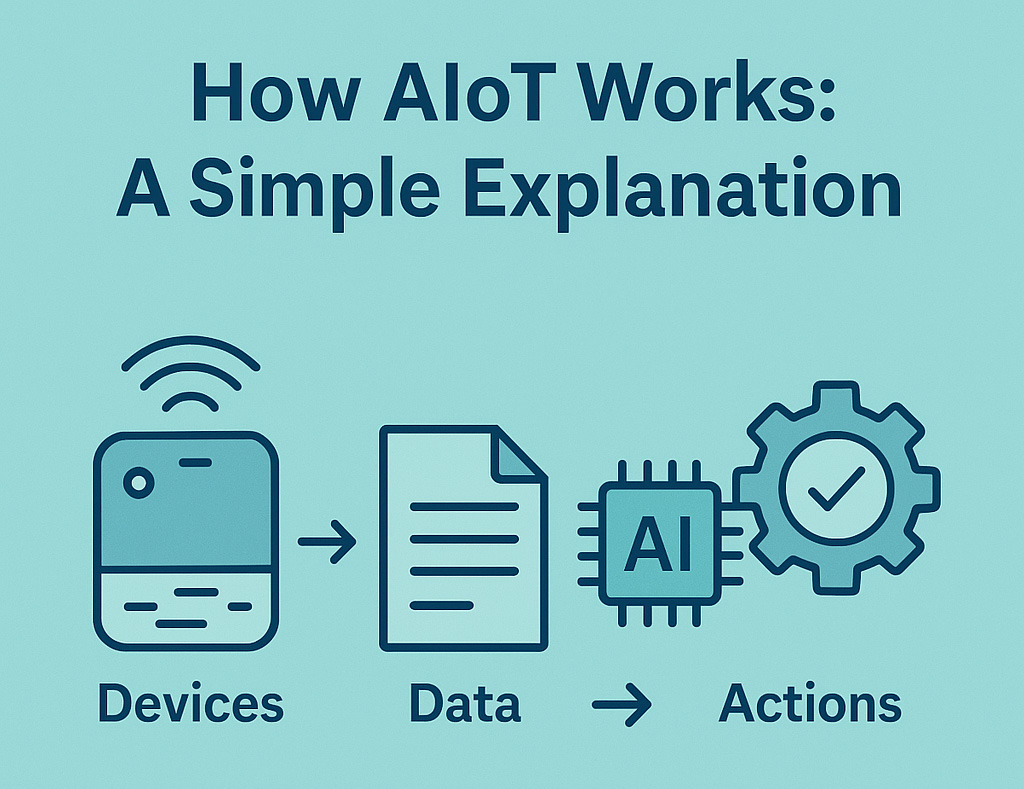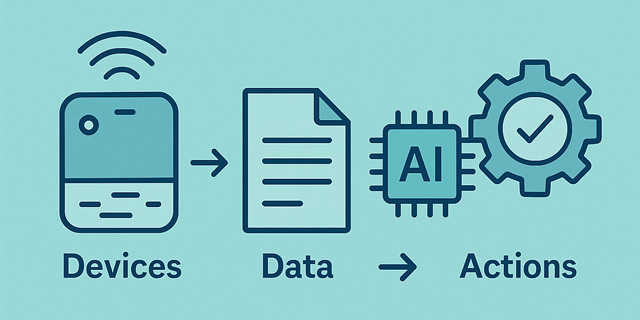So far, we’ve explored what AIoT is and how it’s changing the world. But have you ever wondered: How does an AIoT device actually work?
In this article, we’ll walk through the key steps and components behind an AIoT system, explained in simple terms anyone can understand.
1. What Happens Inside an AIoT Device?
At a high level, an AIoT system follows this process:
Sense → Think → Decide → Act
Let’s break that down.

2. Step 1: Sensing the Environment
Every AIoT device starts with sensors — the “eyes and ears” of the system. These sensors collect real-time data from the world around them.
2.1. Common types of sensors:
- Temperature sensors – for smart thermostats or weather stations.
- Motion sensors – for smart lighting or security systems.
- Camera sensors – for facial recognition or object detection.
- Heart rate or oxygen sensors – for wearable health devices.
Without IoT connectivity, these sensors couldn’t share or use the data effectively.
3. Step 2: Transmitting the Data
After sensing, the device sends the collected data through the internet or a local network.
3.1. This step involves:
- Connectivity protocols like Wi-Fi, Bluetooth, Zigbee, or cellular (4G/5G).
- Sometimes the data goes to the cloud, other times it stays on the edge (more on that below).
This is the “IoT” part — the Internet of Things enables devices to talk to each other and to larger systems.
4. Step 3: Processing the Data (AI at Work)
Now it’s time for the AI to take over.
The data is analyzed by AI algorithms, either:
- Locally (Edge AI) – directly on the device or nearby computer.
- In the Cloud – using powerful remote servers.
4.1. What the AI does:
- Filters noise (e.g., ignores background motion).
- Detects patterns (e.g., unusual heart rate).
- Predicts outcomes (e.g., machine failure).
- Learns over time to improve decisions.
This is where the “intelligence” in AIoT happens.
5. Step 4: Taking Action Automatically
Based on the AI’s analysis, the system makes decisions — often in real time — and takes automatic action.
5.1. Examples of actions:
- Turn on a fan if it’s too hot.
- Lock the door if no one is home.
- Send a medical alert if a heartbeat is irregular.
- Stop a machine to prevent damage.
The goal is to act without needing a human to intervene.
6. Where Does the AI “Live”?
6.1. Option 1: Edge AI (Local Processing)
- Data is processed on the device or nearby hardware.
- Faster, more private, and works without internet.
- Used in cars, cameras, industrial machines.
6.2. Option 2: Cloud AI (Remote Processing)
- Data is sent to cloud servers for deeper analysis.
- More power, better storage.
- Used in applications needing large-scale data comparison (like healthcare or finance).
Many systems use a hybrid approach for the best of both worlds.
7. Visualizing a Simple AIoT Flow
Example: Smart Air Purifier
- Sensor detects poor air quality.
- Data is sent via Wi-Fi.
- AI model analyzes air content.
- Decision: Activate fan at high speed.
- Action: Device turns on and cleans the air.
- Learning: AI remembers patterns (e.g., air gets worse at 6 PM daily).
8. Conclusion
Now you know what happens under the hood of an AIoT device. It’s not magic — it’s the smart combination of:
- Sensing the world through IoT,
- Thinking and learning with AI,
- And acting automatically to help you live better.


